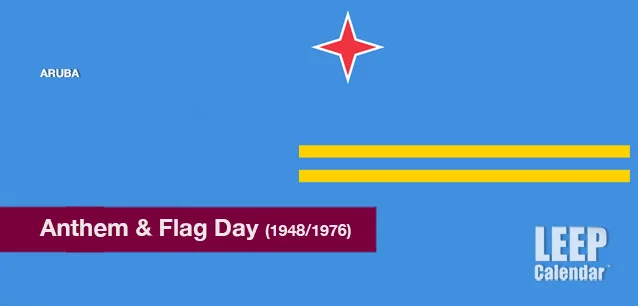 AD
AD
Today is: November 24
Scroll to explore events active on this date.
LEEP INK FEATURES

Nuanced November 2024
November is the start of the holiday season in many parts of the world. It is a time for family, football, food, shopping and decorating, particularly in the Christian and Jewish world, leading to Christmas and...

December's Gift
Events in December 2024. Well, we made it to December. December is the holiday season, particularly in Western nations, where Christianity and Judaism are the faiths most common in the nation's past. ...

August is Appropos
A toddler playing in the fountain at a park in Santa Fe, New Mexico—Photo LD Lewis. In August, we live through the Dog Days of Summer. It's hot and often humid, and those ...
About Aruba's Anthem and Flag Day
Music , Mexico & Central America
Ends: Mar 18, 2025
DESCRIPTION:
Anthem and Flag Day in Aruba: A Celebration of National Identity and Pride
Anthem and Flag Day in Aruba, celebrated annually on March 18, is a significant national holiday commemorating the island's adoption of its national flag and anthem, symbolizing Aruban identity and cultural heritage. This day is a vibrant expression of national pride, marked by ceremonies, cultural events, and public gatherings across the island.
The history of Anthem and Flag Day dates back to 1976, when Aruba first introduced its national flag and anthem, key symbols of its national identity, marking a pivotal moment in Aruba's journey towards greater autonomy within the Kingdom of the Netherlands. The flag and anthem are embodiments of the island's distinct cultural and historical narrative, reflecting its aspirations and values.
The Aruban flag was officially adopted on March 18, 1976. Its design consists of a field of light blue, symbolizing the sea surrounding Aruba, and two narrow horizontal yellow stripes, representing the island's sandy beaches and gold and phosphate mining history. A red star with a white outline dominates the flag, representing the island with its white beaches and the blood shed by Arubans during past struggles. The star's four points signify the four cardinal points, symbolizing the island's diverse origins and the unity of its people.
Aruba's national anthem, "Aruba Dushi Tera" (Aruba Sweet Land), was adopted on the same day. Composed by Juan Chabaya Lampe with lyrics by Rufo Wever, the anthem expresses love and devotion to the island, celebrating its beauty, history, and the resilience of its people. It is a lyrical tribute to Aruba's natural splendor, peaceful way of life, and the pride of its inhabitants.
Anthem and Flag Day in Aruba is not just a public holiday; it's a day of cultural affirmation and unity. Celebrations include official ceremonies, parades, music, dance performances, and educational events. These festivities are imbued with a sense of national pride, reflecting the island's rich cultural tapestry and its journey towards self-determination.
The day is also an opportunity for reflection on Aruba's progress as a nation and its aspirations for the future. It serves as a reminder of the island's unique identity, shaped by its indigenous, Spanish, Dutch, and African influences and the collective spirit of its people.
Anthem and Flag Day in Aruba celebrate national pride and identity, honoring the symbols representing the island's heritage, values, and aspirations. It's a day when Arubans come together to celebrate their history, culture, and achievements, reinforcing their sense of unity and belonging in the global community.
VIDEOS
SUPPORTING DOCUMENTS
Currently, this event does not have supporting documents.
ADDITIONAL IMAGES
Currently, this event does not have supporting images.
Where would you like to go now?
 AD
AD


/footer-logo.svg)
